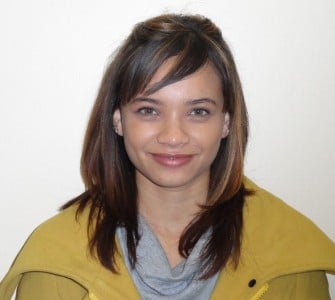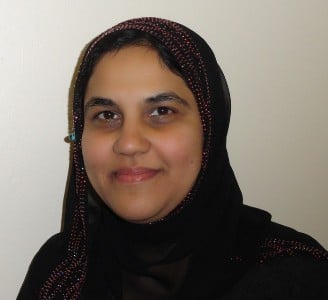We aim to understand the role of the crystalline structure of a material on its properties, with the control of the properties through structural control set as long term goal. The materials that we study are known as organic-inorganic hybrid materials, and combine an organic component and a metal halide component, and the resultant composite material typically possesses properties from both the organic and the inorganic components. Cohesion of the two components can be achieved through coordination bonds, when the organic component coordinates to the metal atom, or through ionic forces, when the organic component is protonated, and an ionic material is formed. Bridging of metal atoms via halogeno ligands may result in one-, two- or three-dimensional structures.
Of specific interest is the magnetic properties of these materials containing the divalent transition metals Mn(II), Co(II) and Cu(II), which are studied experimentally via SQUID magnetometry. This technique allows for determination of the type of magnetic interactions present in the sample – ferromagnetic or antiferromagnetic. Fitting of the experimental data to an applicable quantum mechanical model, provides information on the strength of the magnetic exchange present between ions.
In addition the electronic properties of crystalline samples have been studied by voltage-current measurements which indicated that the materials behave as semi-conductors. In addition, Diffuse Reflectance Spectroscopy (DRS) measurements of coordination polymers have shown their band gaps to fall in the semi-conductor range.
As a result of the semi-conductor behaviour of these materials, their applicability as sensitizers in dye sensitized solar cells (DSSC) is studied.
In addition to experimental measurements, Density Functional Theory (DFT) calculations are employed as an additional tool to study the properties of the materials. Calculated band gap energies have been found to agree relatively well with experimental values, and the band structures of the materials can be correlated with their experimentally observed electronic properties.
Prof Melanie Rademeyer, Associate Professor
Room 3-40, Nat Science Building 1
[email protected]
Tel: 012 420 2511

Ms Shalene Bothma, PhD

Mr Hendrik van der Poll, MSc

Ms Cora Mak, MSc

Dr Cara Slabbert, PhD

Dr Parveen Beebeejaun, PhD

Dr Stefan Coetzee, PhD

Mr Neil Hearne, MSc

Jeffrey C. Monroe, Christopher P. Landee, Melanie Rademeyer and Mark M. Turnbull, Copper(II) Halide Salts with1-(4’-Pyridyl)-Pyridinediium, Inorganics 2020, 8, 18. DOI: 10.3390/inorganics8030018
B.M.P. Beebeejaun-Boodoo, Melanie Rademeyer, Coordination polymers and metallocycles of metal halides with n-(aminomethyl)pyridine, n = 3 or 4: Structures and solid-state fluorescence, Polyhedron, 179, (2020), 114364. DOI: 10.1016/j.poly.2020.114364
Jeffrey C. Monroe, M. Angels Carvajal, Mercè Deumal, Christopher P. Landee, Melanie Rademeyer, Mark M. Turnbull, Revisiting the Role of Hydrogen Bonding in the Strong Dimer Superexchange of a 2D Copper(II) Halide Honeycomb-Like Lattice: Structural and Magnetic Study, Inorg. Chem. 2020, 59, 6319−6331. DOI: 10.1021/acs.inorgchem.0c00433
Stefan Coetzee, Mark M. Turnbull, Christopher P. Landee, Juan J. Novoa, Mercè Deumal, Sergi Vela, Melanie Rademeyer, Assessing Cu2L2X4 dimeric moieties as ferromagnetic building blocks, in double halide-bridged polymers (X = Cl-, Br- and L = benzamide). An experimental and computational study, Polyhedron 185 (2020) 114603. DOI: 10.1016/j.poly.2020.114603
Hearne, N., Turnbull, M. M., Landee, C. P., van der Merwe, E. M., Rademeyer. M., Halide-bi-bridged polymers of amide substituted pyridines and -pyrazines: polymorphism, structures, thermal stability and magnetism CrystEngComm, (2019), 21, 1910 – 1927. DOI: 10.1039/c9ce00071b
Jonathan E. Chellali, Cailyn Keely, Graham Bell, Kimberly L. Dimanno, Tran Tran, Christopher P. Landee, Diane A. Dickie, Melanie Rademeyer, Mark M. Turnbull, Fan Xiao, Cobalt and zinc halide complexes of 4-chloro and 4-methylaniline:Syntheses, structures and magnetic behaviour, Polyhedron, (2019), 168, 1 – 10. DOI: 10.1016/j.poly.2019.04.025
Robert J. Dubois, Christopher P. Landee, Melanie Rademeyer & Mark M. Turnbull, Pyridine-based complexes of copper(II) chloride and bromide: ligand conformation effects on crystal structure. Synthesis, structure and magnetic behavior of Cu(2-Cl-3-X′py)2X2 [X, X′ = Cl, Br], Journal of Coordination Chemistry, 2019, 72, 11, 1785–1809. DOI: 10.1080/00958972.2019.1629429
Beebeejaun-Boodoo, B. M. P., Erasmus, R., Rademeyer, M. Tetrahalometallate salts of N-(4-picolinium)-1,8-naphthalimide: structures and solid-state fluorescence, CrystEngComm (2018), 20, 4875 – 4887. DOI: 10.1039/C8CE00292D
Richardson, A. D., Zirkman, T. J., Kebede, M. T., Landee, C. P., Rademeyer, Turnbull, M. M., Synthesis, structure, and magnetic properties of a family of copper(II) complexes and salts of isoquinoline: (Isoquinoline)nCu(X)2 [X = Cl, Br] and (isoquinolinium)2CuX4(HO)n [X = Cl, Br; n = 0,1], Polyhedron, (2018), 147, 106 – 119. DOI: 10.1016/j.poly.2018.03.018
DuBois, R. J., Landee, C. P., Rademeyer, M., Turnbull, M. M., 2-Chloro-3-fluoropyridine copper(II) complexes and the effect of structural changes on magnetic behaviour, Journal of Coordination Chemistry, (2018), 71, 3534 – 3553. DOI:10.1080/00958972.2018.1527323
Copyright © University of Pretoria 2025. All rights reserved.
Get Social With Us
Download the UP Mobile App